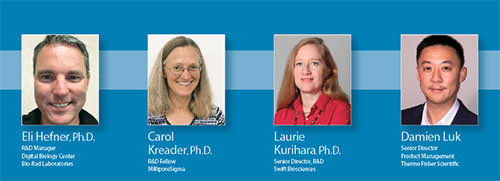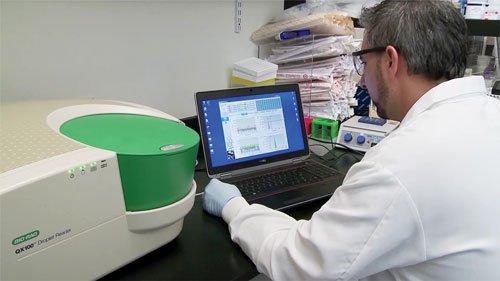October 1, 2016 (Vol. 36, No. 17)
Polymerase Chain Reaction Technology Is Becoming More Powerful, User-Friendly, and Portable—All At Once

Partitioning of a single sample into tens of thousands of reaction modules with the Droplet Digital PCR platform shown above improves the robustness of nucleic acid detection. This, in turn, results in a significant improvement in precision and sensitivity. [Bio-Rad Laboratories]
GEN: Digital PCR (dPCR) was a significant step forward for PCR technology. What do you envision is next on the horizon for PCR?
Dr. Hefner: PCR will continue to be a central component for a variety of nucleic acid analysis solutions. The key steps forward will likely be speed and integration. Partitioning of a single sample into tens of thousands of reaction modules, a capability demonstrated by Bio-Rad’s Droplet Digital PCR (ddPCR), greatly improved robustness of nucleic acid detection. This in turn resulted in a massive improvement in precision and sensitivity.
Because of these improvements, researchers are now probing the limits of what is truth. However, to achieve this leap forward, simplicity and speed were compromised. The future is ripe with opportunities to hone ddPCR through improvements in reaction speed and integration.
Dr. Kreader: Next on the horizon for PCR is targeted multiplex amplification for next-generation sequencing (NGS), that is, the ability to perform multiplex PCR to amplify 10–1,000 target regions of interest (usually a few hundred SNPs) in a single reaction to prepare a library for sequencing. Barcoded libraries, that is, libraries with a different short sequence appended to one primer for each starting sample, can be pooled for sequencing. As a consequence, NGS can be cheaper and provide more information than microarrays or multiple individual PCRs.
Dr. Kurihara: Although digital PCR offers exquisite sensitivity in determining the presence of a target sequence, distinguishing low-frequency single-nucelotide variants (SNVs) present in a high background of wild-type sequence is dependent on the specificity of allele-specific probes (avoidance of probe cross-hybridization). Also, dPCR has a limited multiplexing capability of 16 or less SNV targets in a single assay.
The next horizon for PCR will be improving detection and multiplexing capability for low-frequency SNVs from samples of limiting input quantity, such as liquid biopsy from circulating cell-free DNA (cfDNA). This can be achieved by next-generation sequencing of multiplexed targeted amplicon panels.
Mr. Luk: The consistent needs from our customers doing more PCR are: faster, easier, and cheaper. Doing any one of the three may not be difficult, but achieving all three simultaneously requires real innovation. The future for PCR will be more miniaturization while maintaining simplicity, sensitivity, and specificity.

GEN: What are some of the limiting factors impeding new innovations for PCR technology?
Dr. Hefner: Currently, one of the key areas of innovation, and need, is for speed. Ultrafast thermal modules have pushed the speed limits of standard, well-based reaction blocks. More dramatic gains in speed are possible through reimagining how a sample may be thermally cycled. Improvement in thermal cycling is the next hurdle to be overcome to drive PCR technology forward.
Interestingly, the increased understanding of genetic diversity is calling into question the concept of reference genomes. This requires a rethink of assay design paradigms. Bioinformatics and innovations in oligo design pipelines will need to evolve to meet this challenge.
Dr. Kreader: Limiting factors include specificity and sensitivity. Enzymes for PCR and RT-PCR tend to produce primer-dimer and/or other nonspecific products when target levels are low, such as with single or low cell numbers or low-abundance RNAs, with multiple primer pairs, or when performing one-step RT-PCR. Formulations of enzymes, primers, and/or reagents that enhance specificity and/or reduce nonspecific background are needed for these sensitive applications.
Dr. Kurihara: A liquid biopsy should ideally be performed in a single tube to maximize the input genome copy number to achieve optimal sensitivity for each target (1% LOD = 3/3,300 human genome copies in 10 ng cfDNA). A single-tube assay also reduces set-up time and the likelihood of error in data tracking. However, some target loci may physically overlap, where corresponding target-specific primers overlap, which can impede single-tube capability.
Swift Biosciences has overcome this limitation with a multiplexed PCR technology that can generate overlapping amplicons in a single-tube format. From a 263 amplicon panel, >16,000 COSMIC annotated SNVs can be analyzed using NGS.
Mr. Luk: The cost and time investment required for increasing the simplicity and miniaturization of PCR technology—this may require more design and result in costlier instrumentation. Having equal or better performance for the enzymatic reactions also gets exponentially more difficult at lower volumes. At some point, there comes a limit to the level of investment needed to achieve optimal performance at minimal cost
GEN: Do you think that PCR is going to play a bigger role in point-of-care diagnostics in the near future and, if so, why?
Dr. Hefner: There is an opportunity in rapid molecular disease screening for infectious diseases and oncology. Rapidly identifying the root cause responsible for a patient’s illness and accurately monitoring disease progression during treatment could influence clinical decisions and improve care. As discussed previously, speed and integration are the keys.
Dr. Kreader: Actually, I think methods that use isothermal target or signal amplification could have bigger roles in point-of-care diagnostics than PCR. Thermal cycling, needed for PCR, requires a more complex instrument than isothermal methods. Some of the isothermal methods claim sensitivity rivaling PCR. If achieved reproducibly and robustly, PCR could take a back seat.
Dr. Kurihara: Point-of-care diagnostics will rely on PCR, most likely for pathogen detection for infectious disease, but perhaps also for screening of common resistance mutations to cancer therapies or other alleles relevant to drug response for a variety of conditions. Such testing would improve care by rapidly identifying ineffective treatment options.
Mr. Luk: In the near future, the easiest-to-use technology for molecular diagnostics will continue to consist of PCR-based solutions. For point-of-care diagnostics, simplicity is key for the wide adoption and growth of a broad clinical assay menu. PCR will continue to play a leading role until another technology can achieve the simplicity and affordability that PCR offers today.



